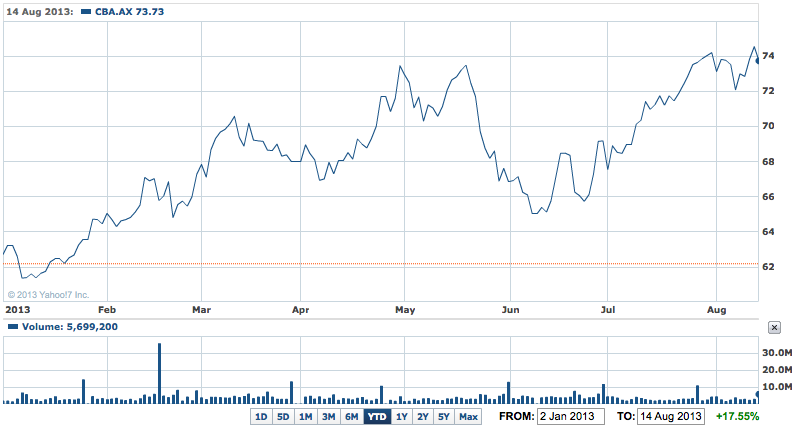By the close of trading yesterday investors seemed to be getting over their little hissy fit about the Commonwealth Bank’s (CBA) record $7.82 billion cash net after tax profit for the 12 months to June 30.
Cash earnings, the best way to measure bank profits, rose 10%, thanks to a strong second half with a cash profit of $4.04 billion, well above a $3.54 billion reported a year ago and stronger than market forecasts of $3.84 billion.
Statutory net profit was also a record at $7.67 billion rise of 8% over the 2011-12 result of $7.09 billion.
Total dividend for the year was boosted to $3.42 a share, up 9%, with the higher final up to $2 a share, from $1.97.
That rise was despite the bank suggesting at the time of its interim profit announcement in February that the final dividends would probably be slightly lower than the $1.97 a share paid for the last half of the 2011-12 year.
CBA shares have risen 36% since last September (and 15% in 2013 so far) on growing hopes, and then expectations that the huge bank would produce another record result – which it did, but the shares were sold off after opening strongly and hitting a day’s high of $75.
They then sold off rapidly to a low of $73.17, before recovering slightly to still close around 1.2% lower at $73.73.
CBA YTD – CBA’s quality result sees profits, dividend higher, shares lower

The sell off was another example of buy on the rumour, then sell on the result which was out before the market opened. There had also been some speculation about a ‘special dividend’ similar to the one Westpac paid in its interim results earlier in the year.
That was absent, but didn’t detract from one of the best results from a major Australian company for this reporting season.
A small question mark was the 14% fall in the bad debt provision to $466 million for the year, despite rising unemployment and suggestions the economy will slow further in the next few months.
It was the fourth consecutive year of record profits for the Commonwealth, but despite that, chief executive Ian Narev was cautious in his outlook yesterday, saying he did not expect an improvement on the “mixed” conditions seen over the last six months.
“Our primary areas of economic focus are the level of confidence of Australian business and households, the impact of economic conditions in China on the demand and price for resources, the value of the Australian dollar and the resultant impact on export-sensitive parts of the Australian economy and the stability of funding markets,” Mr Narev said in a statement accompanying the profit report.
He said indicators in these areas had been “mixed” over the last half and “we expect that to remain the case in the near term".
“So overall, we believe that the underlying conditions for our business in the 2014 financial year will be similar to those we have experienced in the recently completed year.
“However, we are well positioned to meet the needs of our customers should the economy rebound more quickly than anticipated,” he said.
CBA’s net interest margin widened by 4 basis points to 2.13% over the year, thanks to what it said were lower funding costs (i.e. the bank was slow to boost deposit rates and/or borrowed in local wholesale markets at rates lower than expected).
Return on equity was a still high 18.4% (18.6% in the previous year) and is the highest of the big banks. Compared to offshore examples in the UK and US, that’s an extra high level of return and illustrates just how very profitable our big banks are, led by the CBA.
The CBA’s huge retail bank was the main driver of the better than expected result. It lifted earnings 13% to more than $3 billion. The bank also had good contribution from the strong NZ economy where home lending is booming, and from wealth management with the market up by double digits in the year to June.
The CBA said customer deposits rose $26 billion over the year to a total of $405 billion and now account for 63% of total group funding.
At the same time, the bank’s cost to income ratio dropped to 45% from 46%, which is another reason for the stronger than expected rise in earnings.
Reserve Bank figures showed that lending rose 3.1% in the year to June, driven by a 4.6% rise in home lending. That the CBA generated a 10% rise in cash profit (or more than twice the rate of growth in lending) confirms the quality of this result.













